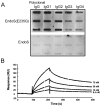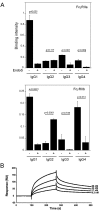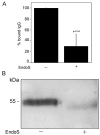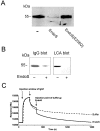Human IgG/Fc gamma R interactions are modulated by streptococcal IgG glycan hydrolysis
- PMID: 18183294
- PMCID: PMC2173940
- DOI: 10.1371/journal.pone.0001413
Human IgG/Fc gamma R interactions are modulated by streptococcal IgG glycan hydrolysis
Abstract
Background: The human pathogen Streptococcus pyogenes produces an endoglycosidase, EndoS that hydrolyzes the chitobiose core of the asparagine-linked glycan on the heavy chain of human IgG. IgG-binding to Fc gamma receptors (Fc gamma R) on leukocytes triggers effector functions including phagocytosis, oxidative burst and the release of inflammatory mediators. The interactions between Fc gamma R and the Fc domain of IgG depend on the IgG glycosylation state.
Methodology/principal findings: Here we show for the first time that EndoS hydrolyzes the heavy chain glycan of all four human IgG subclasses (IgG1-4), in purified form and in a plasma environment. An inactive form of EndoS, obtained by site-directed mutagenesis, binds IgG with high affinity, in contrast to wild type EndoS that only transiently interacts with IgG, as shown by Slot-blotting and surface plasmon resonance technology. Furthermore, EndoS hydrolysis of the IgG glycan influences the binding of IgG to immobilized soluble Fc gamma R and to an erythroleukemic cell line, K562, expressing Fc gamma RIIa. Incubation of whole blood with EndoS results in a dramatic decrease of IgG binding to activated monocytes as analyzed by flow cytometry. Moreover, the IgG bound to K562 cells dissociates when cells are treated with EndoS. Likewise, IgG bound to immobilized Fc gamma RIIa and subsequently treated with EndoS, dissociates from the receptor as analyzed by surface plasmon resonance and Western blot.
Conclusions/significance: We provide novel information about bacterial enzymatic modulation of the IgG/Fc gamma R interaction that emphasizes the importance of glycosylation for antibody effector functions. Moreover, EndoS could be used as a biochemical tool for specific IgG N-glycan hydrolysis and IgG purification/detection, or as a potential immunosuppressing agent for treatment of antibody-mediated pathological processes.
Conflict of interest statement
Figures







References
-
- Ravetch JV, Bolland S. IgG Fc receptors. Annu Rev Immunol. 2001;19:275–290. - PubMed
-
- Burton DR, Woof JM. Human antibody effector function. Adv Immunol. 1992;51:1–84. - PubMed
-
- Arnold JN, Wormald MR, Sim RB, Rudd PM, Dwek RA. The impact of glycosylation on the biological function and structure of human immunoglobulins. Annu Rev Immunol. 2007;25:21–50. - PubMed
-
- Jefferis R, Lund J, Pound JD. IgG-Fc-mediated effector functions: molecular definition of interaction sites for effector ligands and the role of glycosylation. Immunol Rev. 1998;163:59–76. - PubMed
Publication types
MeSH terms
Substances
LinkOut - more resources
Full Text Sources
Other Literature Sources

